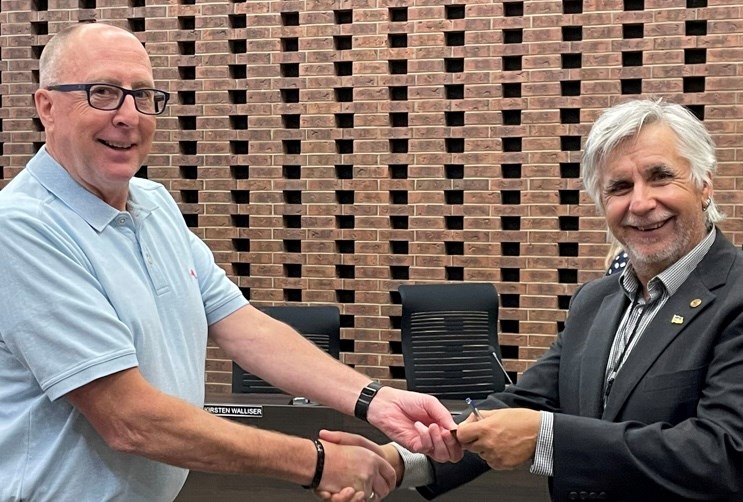ESTEVAN - Buffalo Potash Corp. is looking to make a considerable investment into the Estevan area with two projects that would have a big impact on the local economy.
The City of Estevan issued a news release Thursday stating Buffalo Potash CEO Steve Halabura has formally committed to set up a solution mining research and development (R&D) facility beside the 小蓝视频east College in the Glen Peterson Industrial Park.
It would house a prototype crystallizer and associated process equipment, a chemical analysis laboratory and Buffalo’s regional office.
The facility would offer R&D on potash brines produced from Buffalo’s first mining test sites at Disley and Odessa, and test processes and equipment designed for installation in a larger fertilizer production facility to be built in the Estevan-Bienfait area.
The plant, named the Estevan Fertilizer Production Facility (EFPF), will make upgraded muriate of potash, sulphate of potash, hydrochloric acid and calcium chloride for sale to North American markets.
“With potash, it’s one thing to mine it, but it’s another thing to process and sell it,” said Halabura. “Estevan makes a lot of sense as a site to do that. It’s right on the border, so there’s good interconnection into the U.S.
“Secondly, it’s got a large industrial-based workforce because of the mining. It’s the centre of the oil and gas service and supply sector, and we intend to use solution mining to mine potash. So we’re right in the heart of service mining and fabrication.”
The presence of geothermal power is also an advantage, because the fertilizer plant would require heating, and Halabura said Buffalo Potash is interested in the opportunities provided by geothermal.
The first step in this process is the actual mining, including the Disley and Odessa sites, he said. Buffalo uses a patented mining method called horizontal line-drive mining, which allows them to construct smaller, more environmentally sensitive solution mines. Eventually they would like to have up to six.
“We don’t have as big of a footprint, we don’t generate as much waste and we don’t need as much fresh water,” said Halabura. “Their ultimate build-out is 500,000 tonnes.”
Potash beds are located in and around Estevan and Bienfait, but they’re deep, so mining the mineral here would not be a priority for Buffalo Potash.
For the test facility, Halabura noted solution mining is a bit of an art because it involves a lot of chemistry and principles of physics.
“We need a facility that allows us to analyze the potash content of the brimes coming out of the mines, it allows us to experiment on fine-tuning the mining process. It also allows to test out our crystallizer facility before building the fertilizer factory, so it allows us to do a lot of pre-construction design and planning.”
The test site would be a warehouse-type of building in which they would bring test equipment in and out of the facility, and it would have a laboratory. It would be a similar size to other buildings in the industrial park.
Buffalo Potash will use the facility at first, but Halabura said they might get other research groups involved with them for some joint work. Other producers might find an interest in leasing it.
Saskatchewan is a world leader for potash mining, but Halabura believes it should also be a leader in potash innovation, new designs and solution mining.
Buffalo Potash is in the midst of the design process for the research and development facility. They have 18 months to break ground.
During construction, Halabura estimates the test facility could employ up to 100 people and draw on local contractors. Once it’s complete, he projects five to 10 people would work there.
“I suspect there will be transient people coming and going. When we’re doing certain testing procedures, we may have contractors 小蓝视频 there for a period of weeks or a period of months.”
As for the fertilizer plant, Halabura compared it to the heavy oil business in west-central Saskatchewan with its pools that feed the product in one central upgrader located in Lloydminster.
“For us, our fertilizer upgrader is in Estevan and our mines feed into that.”
Buffalo Potash is in the midst of design work for the plant, which will take at least 12 months to finish. Pre-feasibility is already complete.
“It is an industrial facility. We’ll need to do the environmental on the site, and we haven’t finalized the site for it yet. So there are a number of things we have to do before we can construct the big plant,” said Halabura
They have a few sites in mind, but it’s at the “sensitive stage” where they need to select one or two most suitable spots.
Once it’s finished, the fertilizer plant could employ in the range of 100-200 full-time workers. Construction would bring a lot more people to the Estevan area.
It would be the first fertilizer plant for Buffalo Potash.
“We have a long background in potash. So we spent the past four years working on Buffalo and developing the business model and developing the patents and the technology, finding the specialists and doing the pre-feasibility work.”
Estevan Mayor Roy Ludwig commented that it’s been rewarding to see the Buffalo project advance this far.
“The Buffalo team has demonstrated its commitment to our community and developed the plan from a dream into something that is becoming real. I look forward to seeing the R & D facility come to life,” Ludwig said.
Halabura noted Buffalo Potash has enjoyed the support of the RMs of Estevan and Coalfields and the Town of Bienfait, in addition to the city.
“They have a lot to offer, not just Buffalo, but any industrial maker of resource-based or manufacture commodity. I think that’s one of the secrets about the region. It’s a good place to be.”
The Ocean Man First Nations is also one of their partners, he said.





